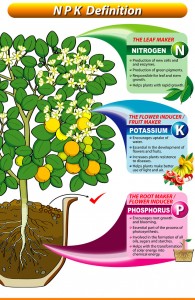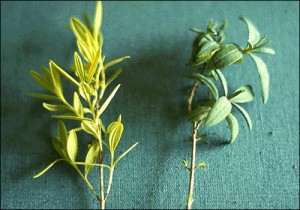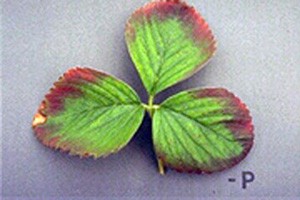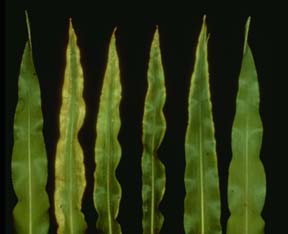It’s that time of year where some plants in your garden are really starting to take off, and some are just hanging back, lingering in early stages of growth, turning weird shades of yellow or purple. ‘What does it all mean??!!’ you may ask yourself. Well, here on the Garden Club blog we want to help you get to the bottom of these nutrient mysteries and help you grow big, tasty, healthy plants.
Most gardeners are familiar with the classic triad of NPK, or nitrogen, phosphorus and potassium. Today we’re going to break these down for you. I highly recommend that every gardener (especially those growing straight in the ground and those with big gardens) get their soil tested each spring. You can buy a cheap test at your local garden center that will give you a rough idea of what’s going on in your soil. On a bigger scale and at a higher cost, a great resource for this is A & L labs – they accept mail-ordered soil samples and provide great explanations to accompany the results.
Once you get your soil test results you’ll know where your soil-based strengths are, and where your soil is lacking. With that information, you can make a plan to add the necessary nutrients back into the soil in solid (think boxes of granulated fertilizer or 50 pound bags of powdered gypsum, etc) or liquid (spray-on fertilizer) form.
Understanding NPK Fertilizers: which ratio is right for you?
It’s important to note that the three numbers listed on bagged and boxed fertilizer containers refers to the percentage (by weight) of the three major nutrients required for healthy plant growth. They always in the same order: nitrogen-phosphorus-potassium (NPK). When in doubt, add a ‘balanced’ fertilizer to your garden – that is, one where these three numbers are pretty close to one another, such as 5-5-5.
If you know your soil is lacking in a particular nutrient, look for the number corresponding to this nutrient to be considerably higher than the other two. Before planting, you may wish to work some fertilizer deep in your soil in order to promote strong root growth – a ratio of around 3-20-20 would work quite well for this.
Additionally, early on in a plant’s life, it needs a lot of nitrogen in order to grow large – so look for the first number corresponding to nitrogen to be higher (16-6-4 is a common ratio for a nitrogen-rich fertilizer).
Later, when it’s time for your plants to flower, you can revert back to the 3-20-20 fertilizer in order to help this phase of growth.
All of these fertilizer options are available in completely organic varieties. Often made with components such as blood meal, bone meal, rock phosphate, kelp, and oyster shell flour, organic fertilizers are potent, effective and free of harsh chemicals. Ask your local garden supply store about organic options.
Let’s look at little bit more closely at these three macro-nutrients and what they do for your plants.

Understanding NPK Fertilizers: Nitrogen
Nitrogen has earned its place at the head of the ‘NPK’ line due to its crucial importance to plant development and growth. Every protein in plants contains nitrogen, and it is involved in almost every process that plants undertake in their life cycle. Growing big leafy canopies and tall green stems are both processes that depend most strongly on nitrogen. We all remember from middle school science class that chlorophyll is responsible for the green pigment in plants and helps the plant carry out photosynthesis. Well, our buddy nitrogen is a key component of chlorophyll, too.
For geeky gardeners like us, deeming something ‘nitrogenous’ is the same as noting that it is green, leafy, soft and moist. (When building compost piles, this is often contrasted with ‘carbonaceous’ materials, which are brown and dry and take longer to break down).
Nitrogen is often especially important in the early phases of a plant’s growth while it’s beneficial for the plant to grow a big scaffolding before it sets fruit. At that point, nitrogen (or too much of it) can actually hinder the process of producing the part of the plant that you’re aiming to eat! For example, last year I was really proud of my low tunnel greenhouse-grown Padron peppers. They began to produce huge, tall plants – growth that I encouraged through a few applications of blood meal, which is very high in nitrogen. Well, low and behold, come September I had shoulder high pepper plants, in a beautiful deep green, with hardly any peppers on them. I had overdone the nitrogen, which delayed and in fact prohibited the plant in switching over from its vegetative stage (producing new green growth) to its reproductive phase (when it grows fruit that will eventually produce seed). Oops.
When plants need it: Throughout their lives but especially early on in their growth- from planting until flowering. Compost and cover crops are great sources of slow-release nitrogen, which will always benefit a plant. But the quick-release form of nitrogen found in fertilizers should only be applied up until a plant is ready to flower.
How to tell if you’re lacking in it: A yellow color where there should be green, a small fruit yield, and/or small, stunted plants. Too much nitrogen, or too much too late in a plant’s cycle, can lead to large plants with delayed reproductive phases – that is, late flowering.

How best to add it: Compost and organic matter is rich in nitrogen, as is fish and kelp solutions, compost tea, and manure.
Understanding NPK Fertilizers: Phosphorus
Also a crucial player in a plant’s photosynthesis, phosphorus helps a plant to develop its sugars, starches, and oils. It helps to make sweet fruit sweet and is a key player in helping plants produce seeds and synthesize protein. It also aids in a plant’s immune system – a plant rich in phosphorus is better able to withstand environmental stresses than a phosphorus-deficient plant. While nitrogen helps a plant grow big healthy leaves, phosphorus helps a plant grow strong roots and then helps to encourage blooming once flower formation has occurred.
When plants need it: Best to add it at planting time or a few days before.
How to tell if you’re lacking in it: Healthy looking fruit that is surprisingly unsweet may be due to a lack of phosphorus. Additionally, stunted plants, small fruit and flower yields, and odd and weak-looking flowers can be signs of phosphorus deficiencies. Too much phosphorus will inhibit a plant’s uptake of zinc as well as other nutrients, meaning that if your soil test indicated that you should amend with high levels of phosphorus, you should make sure to balance other related nutrients as well.

How best to add it: Bone meal is a great powdered form of a quick phosphorus boost.
Understanding NPK Fertilizers: Potassium
Potassium plays an important role in helping plants store, harness, and regulate their energy. Additionally, water pressure within plant cells is regulated with the help of potassium. Throughout a plant’s life it needs to develop the capacity to store and utilize energy and water in order to help it withstand stress (derived from heat or cold, poor soil conditions, improper handling by impatient gardeners, or munching from critters). Potassium in all of its functions aids plants in their ability to respond to and overcome this stress. Potassium is proving to be an important player for me at my cut flower farm – as long, rigid stems require adequate amounts of potassium.
When plants need it: Throughout their lives, but adding before planting time is a good idea.
How to tell if you’re lacking in it: Low yields and deformed leaves (curled, spotted, weak, or scorched) are telltale signs of potassium deficiencies. Conversely, if a plant has too much potassium, it may look big and beautiful but actually be quite weak structurally.

How best to add it: Potassium sulfate or greensand are common products to use that can be worked right in to garden soils before planting.
Two other key players: Calcium and Magnesium
I would be remiss to not give special shoutouts to two other leading ladies: calcium and magnesium. Calcium is another nutrient that helps plants develop strength, yet it also is of importance in helping plants absorb and use all of these other nutrients. A soil rich in one nutrient yet lacking in calcium may grow plants with clear deficiencies in spite of perfectly adequate levels of the macronutrients. Additionally, it helps soils to be more workable. Heavy clay soils often call for additional sources of calcium – often gypsum is recommended.
Magnesium is another key micronutrient that helps plants to activate a whole host of other nutrients. Plant enzymes require magnesium in order to produce carbohydrates and sugars. Additionally, healthy seeds, flowers and fruits require adequate levels of magnesium.
Understanding soil nutrients is a life-long endeavor, and we hope this primer helps you to take a stab at fine-tuning your soil. Do you have any other questions about understanding NPK fertilizers? Ask them in the comments section below and we’ll try to help!
Next time on the blog we’ll be talking about cut flowers, bouquet arrangements, and the importance of planting flowers in your gardens for pollinators.







 Family
Family

